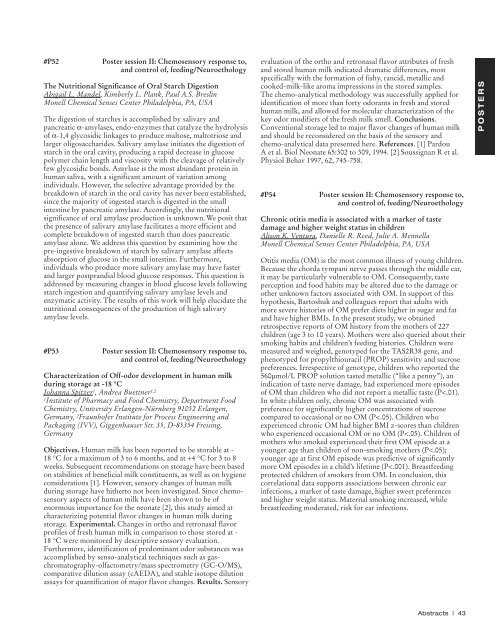2009 Abstracts - Association for Chemoreception Sciences
2009 Abstracts - Association for Chemoreception Sciences
2009 Abstracts - Association for Chemoreception Sciences
Create successful ePaper yourself
Turn your PDF publications into a flip-book with our unique Google optimized e-Paper software.
#P52 Poster session II: Chemosensory response to,and control of, feeding/NeuroethologyThe Nutritional Significance of Oral Starch DigestionAbigail L. Mandel, Kimberly L. Plank, Paul A.S. BreslinMonell Chemical Senses Center Philadelphia, PA, USAThe digestion of starches is accomplished by salivary andpancreatic a-amylases, endo-enzymes that catalyze the hydrolysisof a-1,4 glycosidic linkages to produce maltose, maltotriose andlarger oligosaccharides. Salivary amylase initiates the digestion ofstarch in the oral cavity, producing a rapid decrease in glucosepolymer chain length and viscosity with the cleavage of relativelyfew glycosidic bonds. Amylase is the most abundant protein inhuman saliva, with a significant amount of variation amongindividuals. However, the selective advantage provided by thebreakdown of starch in the oral cavity has never been established,since the majority of ingested starch is digested in the smallintestine by pancreatic amylase. Accordingly, the nutritionalsignificance of oral amylase production is unknown. We posit thatthe presence of salivary amylase facilitates a more efficient andcomplete breakdown of ingested starch than does pancreaticamylase alone. We address this question by examining how thepre-ingestive breakdown of starch by salivary amylase affectsabsorption of glucose in the small intestine. Furthermore,individuals who produce more salivary amylase may have fasterand larger postprandial blood glucose responses. This question isaddressed by measuring changes in blood glucose levels followingstarch ingestion and quantifying salivary amylase levels andenzymatic activity. The results of this work will help elucidate thenutritional consequences of the production of high salivaryamylase levels.#P53 Poster session II: Chemosensory response to,and control of, feeding/NeuroethologyCharacterization of Off-odor development in human milkduring storage at -18 °CJohanna Spitzer 1 , Andrea Buettner 1,21Institute of Pharmacy and Food Chemistry, Department FoodChemistry, University Erlangen-Nürnberg 91052 Erlangen,Germany, 2 Fraunhofer Institute <strong>for</strong> Process Engineering andPackaging (IVV), Giggenhauser Str. 35, D-85354 Freising,GermanyObjectives. Human milk has been reported to be storable at -18 °C <strong>for</strong> a maximum of 3 to 6 months, and at +4 °C <strong>for</strong> 3 to 8weeks. Subsequent recommendations on storage have been basedon stabilities of beneficial milk constituents, as well as on hygieneconsiderations [1]. However, sensory changes of human milkduring storage have hitherto not been investigated. Since chemosensoryaspects of human milk have been shown to be ofenormous importance <strong>for</strong> the neonate [2], this study aimed atcharacterizing potential flavor changes in human milk duringstorage. Experimental. Changes in ortho and retronasal flavorprofiles of fresh human milk in comparison to those stored at -18 °C were monitored by descriptive sensory evaluation.Furthermore, identification of predominant odor substances wasaccomplished by senso-analytical techniques such as gaschromatography-olfactometry/massspectrometry (GC-O/MS),comparative dilution assay (cAEDA), and stable isotope dilutionassays <strong>for</strong> quantification of major flavor changes. Results. Sensoryevaluation of the ortho and retronasal flavor attributes of freshand stored human milk indicated dramatic differences, mostspecifically with the <strong>for</strong>mation of fishy, rancid, metallic andcooked-milk-like aroma impressions in the stored samples.The chemo-analytical methodology was successfully applied <strong>for</strong>identification of more than <strong>for</strong>ty odorants in fresh and storedhuman milk, and allowed <strong>for</strong> molecular characterization of thekey odor modifiers of the fresh milk smell. Conclusions.Conventional storage led to major flavor changes of human milkand should be reconsidered on the basis of the sensory andchemo-analytical data presented here. References. [1] PardouA et al. Biol Neonate 65:302 to 309, 1994. [2] Soussignan R et al.Physiol Behav 1997, 62, 745-758.#P54 Poster session II: Chemosensory response to,and control of, feeding/NeuroethologyChronic otitis media is associated with a marker of tastedamage and higher weight status in childrenAlison K. Ventura, Danielle R. Reed, Julie A. MennellaMonell Chemical Senses Center Philadelphia, PA, USAOtitis media (OM) is the most common illness of young children.Because the chorda tympani nerve passes through the middle ear,it may be particularly vulnerable to OM. Consequently, tasteperception and food habits may be altered due to the damage orother unknown factors associated with OM. In support of thishypothesis, Bartoshuk and colleagues report that adults withmore severe histories of OM prefer diets higher in sugar and fatand have higher BMIs. In the present study, we obtainedretrospective reports of OM history from the mothers of 227children (age 3 to 10 years). Mothers were also queried about theirsmoking habits and children’s feeding histories. Children weremeasured and weighed, genotyped <strong>for</strong> the TAS2R38 gene, andphenotyped <strong>for</strong> propylthiouracil (PROP) sensitivity and sucrosepreferences. Irrespective of genotype, children who reported the560µmol/L PROP solution tasted metallic (“like a penny”), anindication of taste nerve damage, had experienced more episodesof OM than children who did not report a metallic taste (P
















